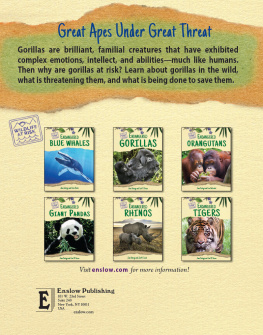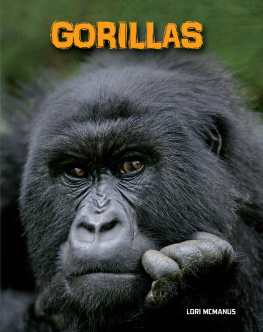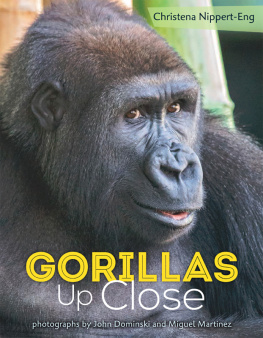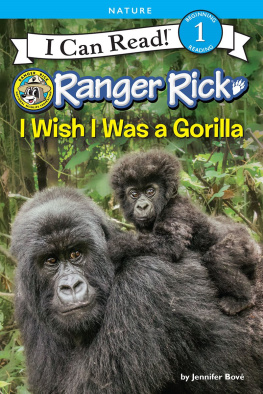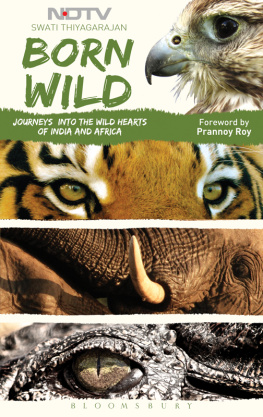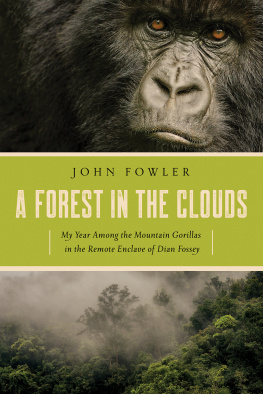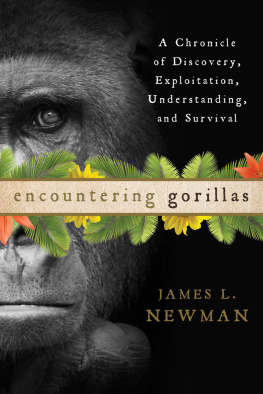Carl R. Green - Endangered Gorillas
Here you can read online Carl R. Green - Endangered Gorillas full text of the book (entire story) in english for free. Download pdf and epub, get meaning, cover and reviews about this ebook. year: 2015, publisher: Enslow Publishing, LLC, genre: Romance novel. Description of the work, (preface) as well as reviews are available. Best literature library LitArk.com created for fans of good reading and offers a wide selection of genres:
Romance novel
Science fiction
Adventure
Detective
Science
History
Home and family
Prose
Art
Politics
Computer
Non-fiction
Religion
Business
Children
Humor
Choose a favorite category and find really read worthwhile books. Enjoy immersion in the world of imagination, feel the emotions of the characters or learn something new for yourself, make an fascinating discovery.
- Book:Endangered Gorillas
- Author:
- Publisher:Enslow Publishing, LLC
- Genre:
- Year:2015
- Rating:3 / 5
- Favourites:Add to favourites
- Your mark:
- 60
- 1
- 2
- 3
- 4
- 5
Endangered Gorillas: summary, description and annotation
We offer to read an annotation, description, summary or preface (depends on what the author of the book "Endangered Gorillas" wrote himself). If you haven't found the necessary information about the book — write in the comments, we will try to find it.
Gorillas are brilliant, familial creatures that have exhibited complex emotions, intellect, and abilities, much like humans. Then why are gorillas at risk? Learn about the daily lives of gorillas in the wild, what is threatening their very survival, and what is being done to save them.
Endangered Gorillas — read online for free the complete book (whole text) full work
Below is the text of the book, divided by pages. System saving the place of the last page read, allows you to conveniently read the book "Endangered Gorillas" online for free, without having to search again every time where you left off. Put a bookmark, and you can go to the page where you finished reading at any time.
Font size:
Interval:
Bookmark:

Published in 2016 by Enslow Publishing, LLC.
101 W. 23rd Street, Suite 240, New York, NY 10011
Copyright 2016 by Enslow Publishing, LLC.
All rights reserved.
No part of this book may be reproduced by any means without the written permission of the publisher.
Library of Congress Cataloging-in-Publication Data
Katirgis, Jane, author.
Endangered gorillas / Jane Katirgis and Carl R. Green.
pages cm. (Wildlife at risk)
Summary: Discusses gorillas, why they are endangered, and how they are being helpedProvided by publisher.
Audience: Ages 11+.
Audience: Grades 7 to 8.
Includes bibliographical references and index.
ISBN 978-0-7660-6898-8 (library binding)
ISBN 978-0-7660-6896-4 (pbk.)
ISBN 978-0-7660-6897-1 (6-pack)
1. GorillaJuvenile literature. 2. Endangered speciesJuvenile literature. 3. GorillaConservation Juvenile literature. I. Green, Carl R., author. II. Title.
QL737.P94K37 2016
599.884dc23
2015009976
Printed in the United States of America
To Our Readers: We have done our best to make sure all Web site addresses in this book were active and appropriate when we went to press. However, the author and the publisher have no control over and assume no liability for the material available on those Web sites or on any Web sites they may link to. Any comments or suggestions can be sent by e-mail to .
Portions of this book originally appeared in the book The Gorilla.
Photos Credits: Ariadne Van Zandbergen/Lonely Planet Images/Getty Images, p..
Cover Credits: Ariadne Van Zandbergen/Lonely Planet Images/Getty Images (gorillas); Creativ Studio Heinemann/Creative (RF)/Getty Images (borage flowers); Joakim Leroy/E+/Getty Images (palm leaf); Maria Toutoudaki/Photodisk/Getty Images (background paper texture).
GORILLAS AT A GLANCE
Scientific Name
Gorilla gorilla. The species divides into three subspecies: western lowland gorilla (Gorilla gorilla gorilla), eastern lowland gorilla (Gorilla gorilla graueri), and mountain gorilla (Gorilla gorilla beringei).
Closest Relatives
Chimpanzees, bonobos (pygmy chimpanzees), orangutans, and humans.
Current Habitat
Western lowland gorillas are found in west-central Africa. Eastern lowland gorillas live in the eastern part of the Congo. Mountain gorillas roam the Virunga Volcanoes region of east-central Africa.
Size and Weight*
Mountain Gorilla:
Adult Male: Height: 5 ft., 8 in. (1.7 m)
Arm Span: 7 ft., 6 in. (2.3 m)
Weight: 350 lbs. (159 kg)
Adult Female: Height: 5 ft. (1.5 m)
Arm Span: 6 ft., 4 in. (1.9 m)
Weight: 190 lbs. (86 kg)
Diet
Gorillas feed on up to 220 plant species and favor the leaves, shoots, fruit, and stems. A large male can eat 40 pounds (18 kg) of food in a day.
Current Populations
Western lowland gorillasabout 100,000
Eastern lowland gorillasfewer than 3,000
Mountain Gorillasabout 880
Special Adaptations
Gorillas, along with chimpanzees and orangutans, display a capacity for complex learning. Some captive gorillas have been taught to communicate with humans by using sign language.
Life Span
In the wild: about 30 years.
In captivity: 35 years or longer. As many as four out of ten wild gorillas die before their sixth birthday.
Vocalizations
Gorillas produce more than twenty different sounds when excited. The sounds range from soft purrs and grunts to loud screeches and roars.
Main Threats
Loss of habitat, poaching, and exposure to diseases.
Legislative Status
All gorillas, particularly the mountain gorilla, are included on endangered species lists. The Great Apes Conservation Act, passed by the US Congress in 2000, commits the United States to the struggle to save Gorilla gorilla.
Organizations Working to Save the Gorilla
Dian Fossey Gorilla Fund
International Gorilla Conservation Progamme (IGCP)
Wildlife Conservation Society
World Wildlife Fund
*Figures represent average measurements.
chapter one
MEET GORILLA GORILLA
Have you ever visited a zoo and spent time admiring the gorillas? Perhaps you were delighted by the playful youngsters chasing each other. Or maybe you were intrigued by the thoughtful looks of adults as they stared back at you. It is not surprising that these primates seem so familiar to us. Up to 99 percent of their DNA is the same as human DNA. However, myths in the past have painted a more aggressive picture of these primates.
For the past four hundred years, reports out of Africa painted the gorilla, to quote 1800s explorer Paul du Chaillu, as a hellish dream creature,... half man, half beast.
Hollywood added to the myth in the classic 1933 film King Kong. This is the plot: While shooting on a remote island, filmmakers run into a 30-foot (9-m) gorilla known as King Kong. As the cameras roll, the snarling, chest-thumping Kong storms into a native village. In the panic that follows, Kong grabs young Ann Darrow (played by Fay Wray) and carries her away. Instead of killing her, the great ape falls in love with his prize. Undaunted, the film crew rescues Ann, captures Kong, and takes him back to New York. There, Kong escapes, seizes Ann, and climbs the Empire State Building. The police are forced to call in Navy warplanes. A baffled Kong swats at the planes until machine-gun fire sends him crashing to the pavement far below.
A Better Understanding
The ferocious gorilla myth survived until modern naturalists rewrote it. George Schaller, first on the scene, began his landmark studies in 1959. He ventured into the jungle unarmed despite old stories of gorillas that crushed rifles with their teeth. No animal attacks without good cause, Schaller reasoned. My inclination is to give the charging animal the benefit of the doubt, hoping that it is merely bluffing. The insight turned out to be correct. Schaller lived among gorillas for two years, and never once did a gorilla seriously threaten him.
Schaller detailed his findings in The Mountain Gorilla (1963) and The Year of the Gorilla (1964). Some of his conclusions laid the old myths to rest. First, he found that gorillas are shy, peaceful plant eaters. The scary chest-beating displays the males put on are meant to frighten intruders. If the visitor does not make any threatening moves, the gorillas relax and back away. Dian Fossey, who picked up where Schaller left off, reported similar findings in her book, Gorillas in the Mist (1983). Once she began acting like one of the group, the gorillas accepted her. Fossey imitated their feeding and grooming habits and even learned to belch like a gorilla.
Fast Fact!
Gorillas are color-blind, but their senses of touch, hearing, smell, and taste are very developed.
Schaller and Fosse further blurred the line that divides humans and apes. Gorillas, the naturalists found, use human-like gestures, postures, and expressions. When they wake up in the morning, gorillas stretch and yawn. If upset, they frown. Like any angry two-year-old child, young gorillas throw temper tantrums. Within their family groups, relations tend to be warm and caring. Maybe, scientists reasoned, gorillas can learn to talk.
A Gorilla Named Koko
Photographer Mike Nichols met a new friend some years ago. She welcomed me into her trailer, he writes, and asked what I had in my purse. Did I have a lipstick? A mirror? Could she look at my teeth? Most people would have thought these were strange questions. Nichols, however, felt right at home with Hanabi-Ko, Koko for short. Koko is a western lowland gorilla who talks to visitors in sign language.
Font size:
Interval:
Bookmark:
Similar books «Endangered Gorillas»
Look at similar books to Endangered Gorillas. We have selected literature similar in name and meaning in the hope of providing readers with more options to find new, interesting, not yet read works.
Discussion, reviews of the book Endangered Gorillas and just readers' own opinions. Leave your comments, write what you think about the work, its meaning or the main characters. Specify what exactly you liked and what you didn't like, and why you think so.

